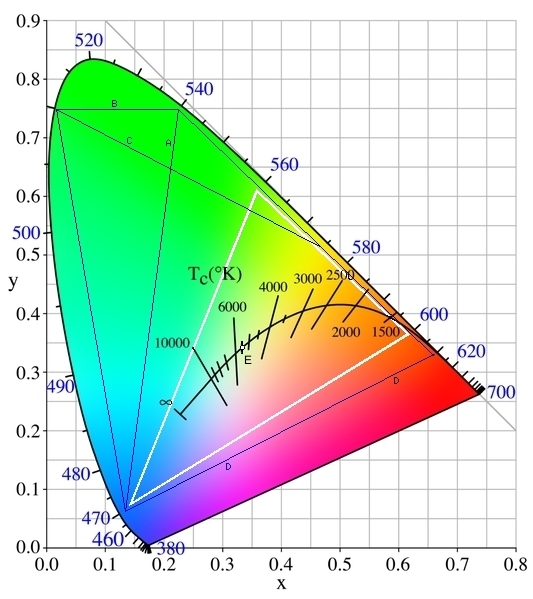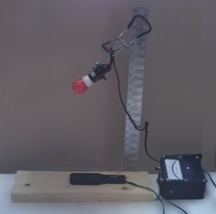WHAT CAN BE USED?
There are several ways this information can be measured:

Color Map
- A light meter for photography gets a good indication of visual brightness stimulus. A corrected selenium cell gives a nice flat result.
- A unit of measure of visual intensity that corresponds to the actual visual stimulus, instead of some energy value, is needed. It should be something similar to the lumen, but for color (e.g. a chromen).
- If the locus of the light can be found on the CIE Chromaticity map (right), the following
can be calculated:
- The dominant hue as a wavelength in nanometers (nm) can be found from the direction of the locus from the equal energy point E on the CIE map.
- Nonspectral hues get the negative of the wavelength found 180° from the direction of the locus from the equal energy point (E on the map).
- The saturation will be distance from the equal energy point to the locus as a percentage of the distance from the equal energy point to the pure hue in that direction.
- The XYZ locus on the CIE map can be reported.
- The CIE locus can be found from modified RGB readings using a mathematical matrix.
- Note the following about the CIE map:
- The white triangle in the CIE map is the gamut of colors visible using a typical white LED.
- The triangle containing lines A and D are the colors visible on a color TV or monitor.
- The quadrilaterals containing lines B and D or lines C and D are proposals for 4-color TVs.
- The curved line through the middle is the set of loci of the various color temperatures of incandescent sources.
- The point E is the equal-energy point where R, G, and B have equal energies for a pure white). It has a color temperature of 5700 K.
- From a spectral plot of the bulb output, we can get the following:
- The spread of wavelengths in the light can be found as the distance in nm between the half-energy points on each side of the dominant hue on the plot.
- If the dominant hue is not emitted by the bulb, the peaks on each side (in nm) can be obtained.
- The standard deviation of the spectral plot intensity is an indication of the choppiness of the curve.
- The spectral plot explains many of the anomalies found in color photography.
 Determine whether or not the light meter uses footcandles or lux.
Determine whether or not the light meter uses footcandles or lux. Here is the explanation of these units of measure:
Here is the explanation of these units of measure: